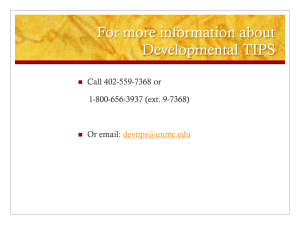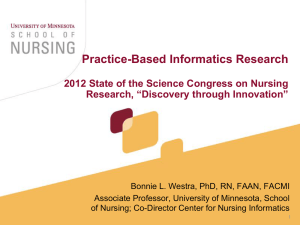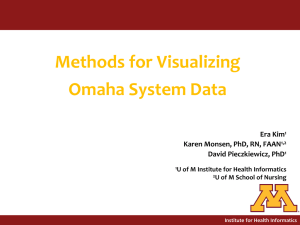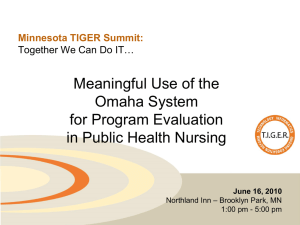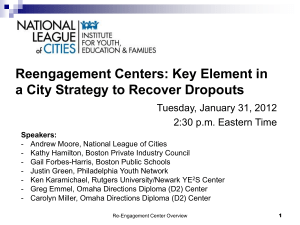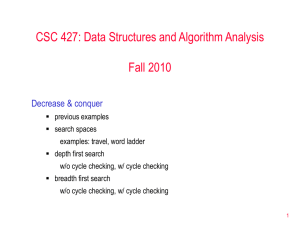Powerpoint - Minnesota Omaha System Users Group
advertisement
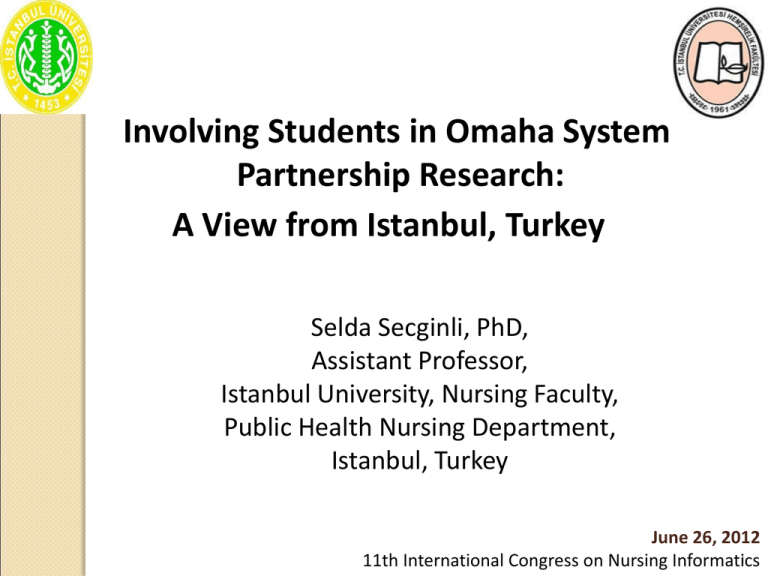
Involving Students in Omaha System Partnership Research: A View from Istanbul, Turkey Selda Secginli, PhD, Assistant Professor, Istanbul University, Nursing Faculty, Public Health Nursing Department, Istanbul, Turkey June 26, 2012 1 11th International Congress on Nursing Informatics Agenda 1. Omaha System 2. Omaha System Partnership 3. Researchs in Omaha System Partnership 4. Omaha System Partnership Benefits 5. Questions 2 Today Quality Technology Information EHR which focus on the individual, computer-based, and easily accessible when needed has become a core in health information systems 3 Omaha System was designed to be relatively; Simple Hierarchical Multidimensional Computer- compatible Used by my faculty team for more than ten years Known Benefits of Partnership Studies An optimal environment in which to enhance practice, evaluate programs, measure outcomes, and improve population health Opportunities for shared knowledge and skills Provide new ways of working Generate new knowledge using large data sets. 5 Three components of the Omaha System Partnership for Knowledge Discovery and Health Care Quality 1. multidisciplinary scientific teams of researchers with experience in advanced data analysis and data mining techniques 2. affiliate members from Turkey to contribute Omaha System data and work together with the scientific team on research projects 3. a warehouse of de-identified clinical Omaha System data including client problems, signs/symptom, interventions, and knowledge, behavior, and status outcomes 6 Omaha System Partnership 7 Researches from Turkey in the Partnership I- Using the Omaha System to Describe Health Problems, Interventions, and Outcomes in Home care in Istanbul, Turkey: A Student Informatics Research Experience (under review) II- Attitudes of Health Professionals Towards Electronic Health Recording in Primary Health Care Settings: A Questionnaire Survey (under writing) 8 Using the Omaha System to Describe Health Problems, Interventions, and Outcomes in Home care in Istanbul, Turkey: A Student Informatics Research Experience Co Principal Investigators: Erdogan S, Secginli S. et al. Istanbul University, Nursing Faculty Purpose: To provide hands-on informatics experience to nursing students; to identify the frequency and type of home care clients' health problems, nursing interventions, and outcomes using the Omaha System 9 Table of Contents Introduction Methods Results Discussion Conclusions 10 Home Care Services in Turkey In 2010, Turkish government included home care services in the Health Transformation Program for the purpose of mainly enable medical care and rehabilitation of the bedridden clients to be performed at home. Home care services are not integrated to the health care and social care sytems of the country, and are not covered by government health insurance held by 90% of the population. Few private sector providers and municipalities offered these services which are generally limited to the larger cities. 11 Table of Contents Introduction Methods Results Discussion Conclusions 12 Approval was obtained from the university institutional review board, 2011/ 393-462 and municipal health services and home health centers directors A software based on Omaha System was used for documentation. Students received training in use of the Omaha System, software program, home visits, and family assessment 159 students visited the clients at home with nurses and did face-to-face interviews in the households Table of Contents Introduction Methods Results Discussion Conclusions 14 Sample and Omaha System Problems The mean age was 66.13 years (SD=18.65) Two-third of the clients had no education/low education (66%) Data were collected from 598 clients Clients received 8657 interventions for 2267 problems Skin, Neuro-musculo- skelatal function, Personal care, and Nutrition were the most common problems The Ten Most Problems and The Intervention Categories The Intervention Categories and The Most Frequent Targets The intervention categories were: Teaching, guidance and counseling (47 %), Treatments and procedures (22 %), Surveillance (22 %) and the Case management (9 %) The most frequent targets were: Dressing change/wound care (776), sign/symptomsphysical (770), skin care (623), positioning (563) and continuity of care (520) Interventions Category According To The Omaha System Domains Average Knowledge, Behaviour and Status Final Ratings Table of Contents Introduction Methods Results Discussion Conclusions 20 Some Points to Discuss- I Three of the 42 Omaha system problems were not addressed within this population (exceptions with Sexuality, Pregnancy, and Postpartum) Home care services (including nursing student and educator visits) may positively affect client knowledge, behavior, and status related to the identified health problems 21 Some Points to Discuss- II The evidence-based care plan of the most common home care problems identified in this study have developed The developed evidence-based care plans could be used in future studies of home care intervention effectiveness The integration of information technology within the curriculum enabled the educators to meet information technology requirements as a component of home care practicum experience 22 Limitations Observational data sets, especially systematic bias that may be introduced through use of students in data collection Inability to randomize clients, and thus inability to attribute causation of outcomes to the interventions of students and educators Study findings may not be generalizable to a broader population and limited comparisons due to the lack of relevant literature on similar programs and settings in Turkey 23 Table of Contents Introduction Methods Results Discussion Conclusions 24 This study mainly demonstrated that 1- Using the Omaha System provides a foundation for evidence-based nursing education in home care and informatics. 2- Omaha System is an useful data collection tool for evaluating problems, interventions, and outcomes in home care, 3- A positive teaching and learning tool for baccalaureate nursing education. Acknowledgements Municipality home care teams Undergraduate nursing students Department research assistants Florence Nightingale Nursing Schools and Hospitals Foundation 26 Omaha System Partnership Benefits- I Built a support network by identifying people involved with information technology in my university and let them know about the Project Dissemination of tools to other researchers 27 Omaha System Partnership Benefits- I Stimulates nurses in home health care team in professional thinking. And the health care teams gained awareness of the importance of nursing documentation and the use of a standardized nursing terminology Students employed nursing informatics at the basic practice level to improve health care delivery and outcome evaluation 28 Omaha System Partnership Benefits- II Gave better insight on delivered care and improved documentation and practice quality Scientific publications A poster was submitted for the 2nd International Public Health Nursing Conference in Minnesota in October 2011 29 Omaha System Partnershıp Benefits- III Presentation of Omaha System outcomes at national and international professional meetings 30 Omaha System Partnershıp Benefits- III A scientific program with international visitors from America and Holland in the faculty 31 Omaha System Partnershıp Benefits- III Foremost, helped us to recognize once that it was very important to embrace new practice models for nursing students such as informatics. And a new course “Nursing Informatics” is going to start in the faculty next year 32 Roadmap ? Future research in Omaha System Partnership in collaboration with The health care teams and postgraduate students Build a support network by identifying more people from Turkey involved with information technology in other universities and let them know about the Partnership Project Disseminate our partnership outcomes and share our experiences especially in other nursing schools in Turkey 33 Thank you for your attention Sabrınız için teşekkürler secginli@istanbul.edu.tr s.secginli@gmail.com

